The $60 CPU Question: AMD Athlon 200GE or Intel Pentium Gold G5400? A Review
by Ian Cutress on January 14, 2019 8:00 AM ESTCPU Performance: System Tests
Our System Test section focuses significantly on real-world testing, user experience, with a slight nod to throughput. In this section we cover application loading time, image processing, simple scientific physics, emulation, neural simulation, optimized compute, and 3D model development, with a combination of readily available and custom software. For some of these tests, the bigger suites such as PCMark do cover them (we publish those values in our office section), although multiple perspectives is always beneficial. In all our tests we will explain in-depth what is being tested, and how we are testing.
All of our benchmark results can also be found in our benchmark engine, Bench.
Application Load: GIMP 2.10.4
One of the most important aspects about user experience and workflow is how fast does a system respond. A good test of this is to see how long it takes for an application to load. Most applications these days, when on an SSD, load fairly instantly, however some office tools require asset pre-loading before being available. Most operating systems employ caching as well, so when certain software is loaded repeatedly (web browser, office tools), then can be initialized much quicker.
In our last suite, we tested how long it took to load a large PDF in Adobe Acrobat. Unfortunately this test was a nightmare to program for, and didn’t transfer over to Win10 RS3 easily. In the meantime we discovered an application that can automate this test, and we put it up against GIMP, a popular free open-source online photo editing tool, and the major alternative to Adobe Photoshop. We set it to load a large 50MB design template, and perform the load 10 times with 10 seconds in-between each. Due to caching, the first 3-5 results are often slower than the rest, and time to cache can be inconsistent, we take the average of the last five results to show CPU processing on cached loading.

As a single threaded test, application loading is a key part of the user experience. Unfortunately the AMD 200GE is 21% slower in this case.
FCAT: Image Processing
The FCAT software was developed to help detect microstuttering, dropped frames, and run frames in graphics benchmarks when two accelerators were paired together to render a scene. Due to game engines and graphics drivers, not all GPU combinations performed ideally, which led to this software fixing colors to each rendered frame and dynamic raw recording of the data using a video capture device.
The FCAT software takes that recorded video, which in our case is 90 seconds of a 1440p run of Rise of the Tomb Raider, and processes that color data into frame time data so the system can plot an ‘observed’ frame rate, and correlate that to the power consumption of the accelerators. This test, by virtue of how quickly it was put together, is single threaded. We run the process and report the time to completion.

In a similar light, the single threaded nature of this test shines on an AMD processor that is 18.6% slower than the Intel competition.
3D Particle Movement v2.1: Brownian Motion
Our 3DPM test is a custom built benchmark designed to simulate six different particle movement algorithms of points in a 3D space. The algorithms were developed as part of my PhD., and while ultimately perform best on a GPU, provide a good idea on how instruction streams are interpreted by different microarchitectures.
A key part of the algorithms is the random number generation – we use relatively fast generation which ends up implementing dependency chains in the code. The upgrade over the naïve first version of this code solved for false sharing in the caches, a major bottleneck. We are also looking at AVX2 and AVX512 versions of this benchmark for future reviews.
For this test, we run a stock particle set over the six algorithms for 20 seconds apiece, with 10 second pauses, and report the total rate of particle movement, in millions of operations (movements) per second. We have a non-AVX version and an AVX version, with the latter implementing AVX512 and AVX2 where possible.
3DPM v2.1 can be downloaded from our server: 3DPMv2.1.rar (13.0 MB)
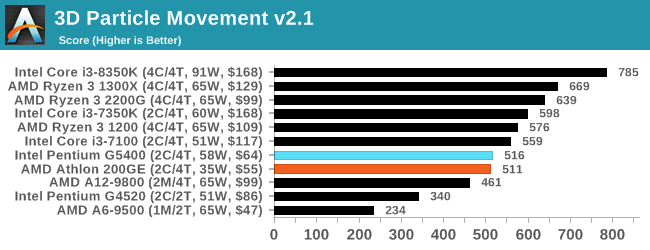
For pure unoptimized throughput, both processors are similar in the 3DPM test.
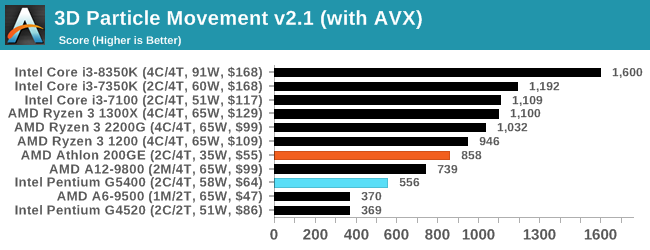
But if we crank on the tuned AVX code, the AMD 200GE scores a big win. On the Pentium, the different code path had almost zero effect, with less than a 10% increase in performance, but the 200GE went up by a good 60% by comparison.
Dolphin 5.0: Console Emulation
One of the popular requested tests in our suite is to do with console emulation. Being able to pick up a game from an older system and run it as expected depends on the overhead of the emulator: it takes a significantly more powerful x86 system to be able to accurately emulate an older non-x86 console, especially if code for that console was made to abuse certain physical bugs in the hardware.
For our test, we use the popular Dolphin emulation software, and run a compute project through it to determine how close to a standard console system our processors can emulate. In this test, a Nintendo Wii would take around 1050 seconds.
The latest version of Dolphin can be downloaded from https://dolphin-emu.org/
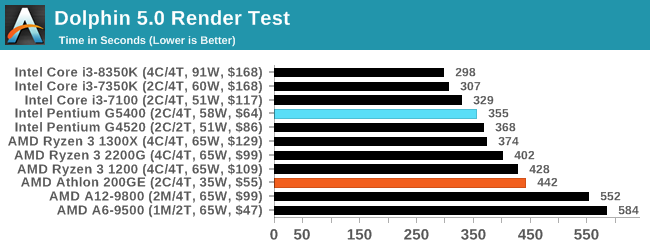
Our emulation test has always been a strong performer for Intel CPUs.
DigiCortex 1.20: Sea Slug Brain Simulation
This benchmark was originally designed for simulation and visualization of neuron and synapse activity, as is commonly found in the brain. The software comes with a variety of benchmark modes, and we take the small benchmark which runs a 32k neuron / 1.8B synapse simulation, equivalent to a Sea Slug.
We report the results as the ability to simulate the data as a fraction of real-time, so anything above a ‘one’ is suitable for real-time work. Out of the two modes, a ‘non-firing’ mode which is DRAM heavy and a ‘firing’ mode which has CPU work, we choose the latter. Despite this, the benchmark is still affected by DRAM speed a fair amount.
DigiCortex can be downloaded from http://www.digicortex.net/
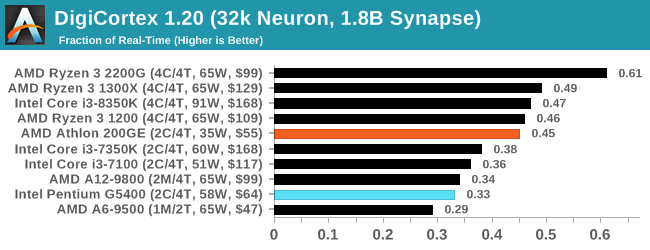
On this more memory limited test, the official supported frequency of the 200GE comes into play, and it scores 37% more than the Intel chip.
y-Cruncher v0.7.6: Microarchitecture Optimized Compute
I’ve known about y-Cruncher for a while, as a tool to help compute various mathematical constants, but it wasn’t until I began talking with its developer, Alex Yee, a researcher from NWU and now software optimization developer, that I realized that he has optimized the software like crazy to get the best performance. Naturally, any simulation that can take 20+ days can benefit from a 1% performance increase! Alex started y-cruncher as a high-school project, but it is now at a state where Alex is keeping it up to date to take advantage of the latest instruction sets before they are even made available in hardware.
For our test we run y-cruncher v0.7.6 through all the different optimized variants of the binary, single threaded and multi-threaded, including the AVX-512 optimized binaries. The test is to calculate 250m digits of Pi, and we use the single threaded and multi-threaded versions of this test.
Users can download y-cruncher from Alex’s website: http://www.numberworld.org/y-cruncher/
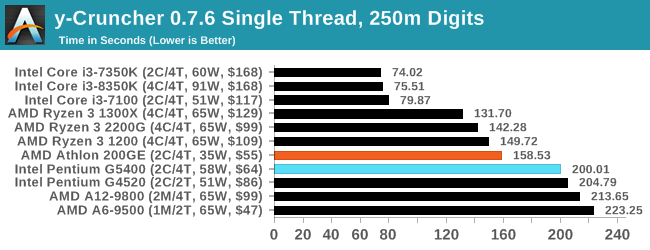
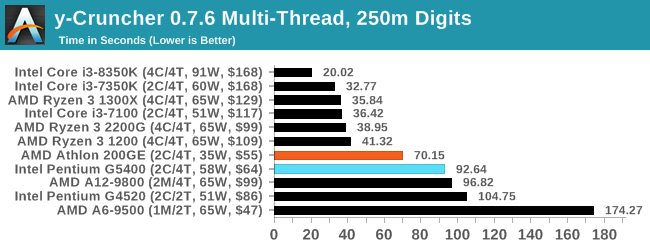
For our second AVX optimized test, AMD again scores a win. It would appear that the Pentium chips from Intel do not seem to be implementing the performance uplifts we see with the Core models.
Agisoft Photoscan 1.3.3: 2D Image to 3D Model Conversion
One of the ISVs that we have worked with for a number of years is Agisoft, who develop software called PhotoScan that transforms a number of 2D images into a 3D model. This is an important tool in model development and archiving, and relies on a number of single threaded and multi-threaded algorithms to go from one side of the computation to the other.
In our test, we take v1.3.3 of the software with a good sized data set of 84 x 18 megapixel photos and push it through a reasonably fast variant of the algorithms, but is still more stringent than our 2017 test. We report the total time to complete the process.
Agisoft’s Photoscan website can be found here: http://www.agisoft.com/
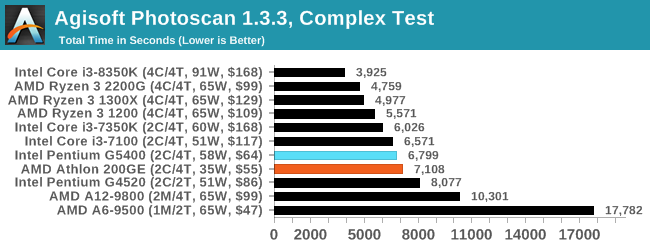
Photoscan is more of a mixed workload, with multithreaded and singlethreaded steps to get a good sense of a performance. The Intel processor slips a win here, a few percent faster than the AMD.


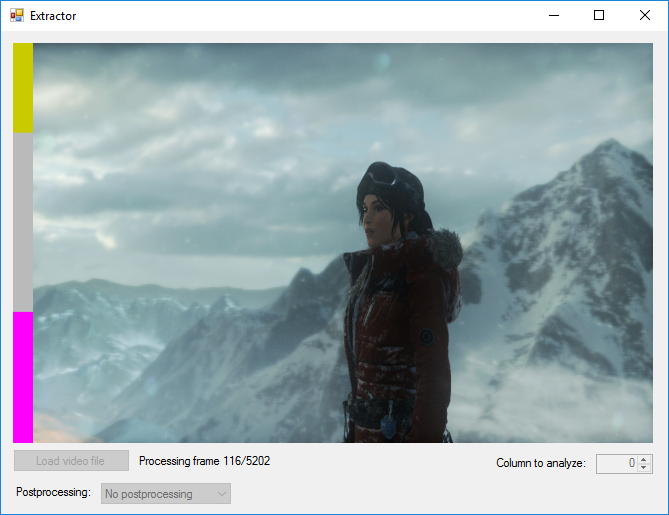










95 Comments
View All Comments
Irata - Monday, January 14, 2019 - link
Did some checking and in the US, I found the G5400 on sale for $129.99 at Newegg. The Athlon GE 200 was $ 59.99.The Intel CPU (LGA 1151 300 series) that had the same price was the Celeron G4920 - it's a 2C2T CPU (G5400: 2C/4T), has half the L3 cache of the G5400 and runs at 3.2 vs. 3.7 Ghz.
In Germany, I checked Mindfactory and the Pentium Gold G5400 was available for a more reasonable € 86.37. For around the same price you can get a Ryzen 3 2200G - if you want an iGPU - or if you don?t, you can get a Ryzen 3 1200 for € 10 less.
So from an actual retail price performance perspective, things look quite different - don't you guys check the store links that are embedded in the article ?
One last thing - which sane person would combine either the Athlon GE or the Pentium Gold with a GTX 1080 ?
PeachNCream - Monday, January 14, 2019 - link
"One last thing - which sane person would combine either the Athlon GE or the Pentium Gold with a GTX 1080?"No one, but for other Anandtech benchmarks carried out over the course of this year on upcoming CPUs that will also use a 1080, this will mean the results will be comparable and the GPU will not act as a bottleneck at sub-4k resolutions.
Irata - Monday, January 14, 2019 - link
But the article clearly says that "In gaming with a discrete graphics card, for example, if you've invested in something like the GTX 1080, the Intel Pentium will push more frames and higher minimums in practically every test at every resolution."I am not saying this is not correct - the G5400 runs @ 3.7 Ghz vs. the Athlon's 3.2 Ghz - but again even mentioning something like this... if you go for either of the two APU, it is because you want / need to spend the minimum money available, so it's definitely not GTX 1080 territory. I could see them mentioning something in the RX 1030 Ti / 1050 / RTX 560 range but even then there are better alternatives.
sing_electric - Monday, January 14, 2019 - link
I don't think that anyone would realistically pair a $55 CPU with a GPU that's worth 10x that (except in oddball cases- like a base that you plan on upgrading), but that they didn't want any of the benchmarks to be GPU-limited. If they used say, a GTX 1030/50 or RX 550/60, some of the benchmarks might have been GPU-limited and would make the AMD and Intel parts look similar in ways they're not.A good, but separate idea is to do builds that hit various price points using combinations of AMD and Intel CPUs with/without dGPUs to see where you win. At today's prices, ~$250 is enough for a cheap-ish enclosure/psu ($70), 8GB DDR4 ($55), 256GB SSD ($60) and mobo ($60), so for $300 you'd be comparing these 2 processors with IGP, but for $400+ things get interesting (since you could compare say, the Ryzen 3 and 5 APUs vs. this chip with a dGPU), and $500+ things get a lot more interesting. For $600+, you're in a place where you have a lot of flexibility with creating a system that works for your use case (including more storage, RAM, etc.)
Irata - Monday, January 14, 2019 - link
Very good suggestion actually - the builds at different price points including all needed hardware.As for the GPU benchmarks - on one hand I do understand that they don't want a GPU bottleneck, but realistically if buyers in this range do not go for GPU that cost more than 150-200 and they do get identical results, then this is what matters to the buyer.
That said, I still think that the Pentium Gold would make for good budget gaming PC paired with something like a GTX 1050 Ti *if* it were available at MSRP - would definitely prefer it to the Athlon GE at that price point.
Funny thing is Ian says "y. The two chips in today’s analysis, the Intel Pentium Gold G5400 and the AMD Athlon 200GE, cost around $60 apiece, which I forked out for personally as I was never expecting to be sampled."
The question is: When and where ? The Intel CPU shortage has been going on for a few months now, so if he got it right after release, it may have been worth checking prices before writing the article.
If there is a store that has them in stock for this price, it would be helpful to say which one it is.
But it's not and it hasn't been so I quite fail to see the point of this article. You either get a much better CPU / APU from AMD for the same price or a much worse (lower clocked 2C/2T Celeron) Intel based CPU
silverblue - Tuesday, January 15, 2019 - link
It would make sense to benchmark on a GTX 1030 (GDDR5) or RX 550 in addition to the 1080 to show what you could expect with more likely hardware, in addition to highlighting the Pentium's superior IPC out of the box.We would definitely appreciate that overclocked test suite, that's for certain. I know people will say that the Athlon isn't supposed to be overclocked, but given that a handful of motherboard manufacturers are now offering this - MSI, ASUS and Gigabyte to name three - I feel that it could be a viable alternative if you really need cheap and cheerful.
ikjadoon - Monday, January 14, 2019 - link
This article is about a year-late on MSRP pricing, unfortunately:https://camelcamelcamel.com/Intel-Pentium-Desktop-...
That 14nm supply shortage: by the time prices go back down, Sunny Cove will be out, so where does article fit?
As hardware gets EOL'd, it raises in price, so these things will be priced even worse.
sing_electric - Monday, January 14, 2019 - link
The way I read that is that Intel has gotten very good at 14nm yields, and no longer has (m)any processors with enough issues that they have to sell them as a G5400, and can instead sell them as faster, higher end parts.ikjadoon - Monday, January 14, 2019 - link
You missed the key issue. "...instead sell them as faster, higher-end, and *more expensive* parts." They might make more money selling "working chips with disabled features" at $65 than "working chips with all features" at $120.Unless Intel is selling a product reliably at $55 to $85, then it's lost sales. These Pentiums are the default in the $250 to $500 office PC space.
sing_electric - Tuesday, January 15, 2019 - link
When there's not a shortage, sure, you sell good chips with disabled features, since you'd rather sell a Core i3 than have an i5 unsold, and you'd rather sell a Pentium than have an i3 stuck in channel, but *right now* Intel's capacity-constrained: They can't make enough higher-end parts to meet demand, so it seems like they're really trying to sell every chip as the highest-end version of whatever it is (they're even selling chips with disabled IGP at the high end, presumably because the IGP is faulty).